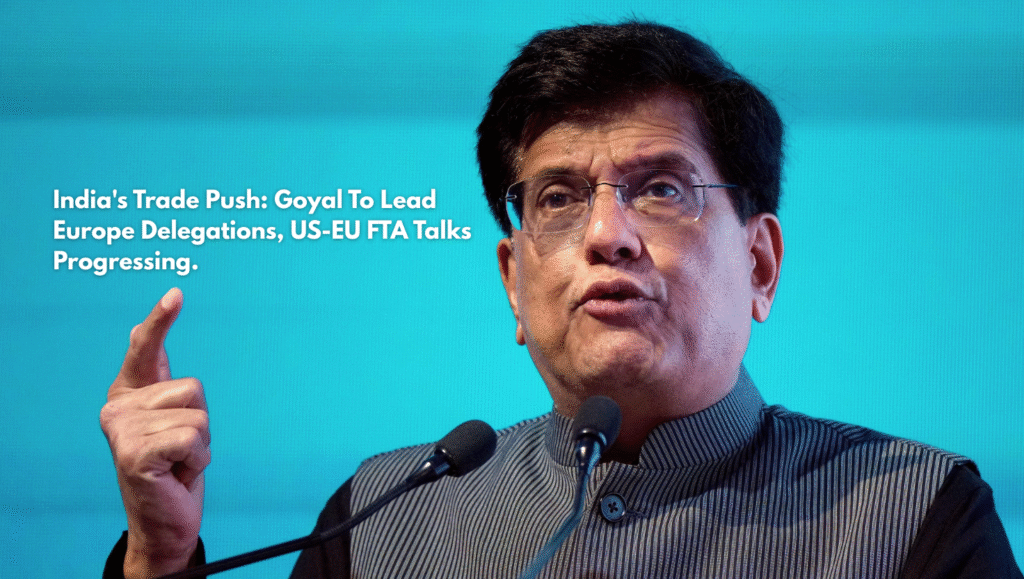
India is stepping up global trade push as Commerce and Industry Minister Piyush Goyal is set to lead top-level business delegations to France and Italy next week, marking strong momentum in India’s free trade agreement (FTA) talks with the United States and the European Union.
Addressing the CII Business Summit on May 29, Goyal declared that FTA negotiations with both the US and the EU are “well on track,” with huge foreign direct investment (FDI) commitments, including one for $100 billion from the European Free Trade Association (EFTA), highlighting India’s increasing popularity as an international trade hub.
Goyal’s tour of Europe, beginning in Paris, will consist of main meetings to enhance trade and investment relations, followed by a visit to Italy along with an industry delegation.
Another Indian business delegation will be visiting Switzerland, marking India’s strategic outreach to EFTA nations—Switzerland, Norway, Iceland, and Liechtenstein—that have committed $100 billion in FDI over 15 years as part of their Trade and Economic Partnership Agreement (TEPA) inked in March 2024.
This is in addition to India’s economy, which has just registered a 7.4% GDP growth in Q4 FY25, seeking to use its $3.84 trillion market to secure deeper investment and technology transfers.
The US-India Bilateral Trade Agreement (BTA) is in its final phases, with the negotiators aiming to complete the first phase by September-October 2025 and doubling bilateral trade to $500 billion by 2030 from its current level of $191 billion. India is seeking increased access to technology, specifically in AI, semiconductors, and quantum technology, to match US allies Australia and the UK. Recent talks in Washington, led by Commerce Secretary-designate Rajesh Agarwal from April 23-26, advanced discussions on market access and tariff reductions, with India offering concessions in pharmaceuticals to secure the deal.
FTA negotiations with the EU, resumed in June 2022 after an eight-year hiatus, are also progressing swiftly, with a year-end deadline set by Prime Minister Narendra Modi and European Commission President Ursula von der Leyen.
Goyal, who met with EU Trade Commissioner Maroš Šefčovič in Brussels on May 23, was hopeful of finalizing a “comprehensive” deal, riding on complementary economies. Cross-border commerce, worth $180 billion for 2023-24, is set to increase, with the EU’s $117.34 billion FDI stock indicating its position as a priority partner.
But Goyal stressed equal respect, pushing back at EU demands to open India’s dairy industry and resisting non-trade concerns such as carbon taxes and deforestation rules.

India’s trade policy is supported by recent gains, such as the EFTA agreement, which has offered 10 lakh jobs and duty cuts on Swiss watches, chocolates, and drugs. Goyal also mentioned new FTA negotiations with New Zealand, for which there is a meeting scheduled in Paris next week, and negotiations with the UK in progress, to wrap up soon after 14 rounds since January 2022.
These agreements look to increase market access for Indian goods such as textiles, pharmaceuticals, and steel and promote robust supply chains in times of world uncertainties.
Government efforts are backing this trade boom. The Production-Linked Incentive (PLI) scheme, with a Rs. 50,000 crore allocation to the National Research Foundation, rewards production, while PM Gati Shakti simplifies logistics for export competitiveness.
The Skill India Digital Hub has readied 2 million workers since 2023, but just 10% are equipped with trade-related technologies, according to Nasscom. Consumer sentiment on X is optimistic, with tweets hailing India’s FTA advancement and global trade reputation. “Goyal’s Europe push and US-EU FTA talks mark India’s emergence as a trade powerhouse!
The high cost of production in Europe and the $1,000-per-capita economy of India, as opposed to the EU’s $60,000, make it difficult to negotiate, necessitating care for India’s growth ambitions.
Non-tariff barriers such as the EU’s Carbon Border Adjustment Mechanism would increase the cost of Indian exports, with 20-35% tariffs imposed on steel and cement from January 2026.
MSMEs that make up 40% of the contribution to exports suffer from adoption bottlenecks on account of compliance costs of Rs. 1-2 lakh a month, according to a 2024 SIDBI report.
Patent approval delays (4-6 years compared to China’s 2 years) slow down innovation even further. Experts provide solutions. Subsidies under Technology Upgradation Scheme can reduce MSME expenses. Increased trade-oriented training under Skill India can fill skill gaps.
Public-private collaborations with IITs and international companies can speed up R&D for export competition. CII-led initiatives can raise awareness on FTA advantages, which can stimulate export growth.
Goyal’s Europe mission and advancing FTA talks with the US and EU position India as a trusted, rules-based trading partner.
With a projected $30-35 trillion economy in two decades, India’s trade pacts are set to reshape global supply chains, fostering prosperity and resilience.
